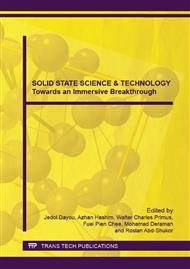[1]
F.P. Incropera, D.P. Dewitt T.L. Bergman and A.S. Lavine, Fundamentals of heat and mass transfer, (6th ed. ). Asia: John Wiley & Sons, (2007).
Google Scholar
[2]
M. Shafiei, K. Kalantar-zadeh, W. Wlodarski, E. Comini, M. Ferroni, G. Sberveglieri, S. Kaciulis and L. Pandolfi, Hydrogen gas sensing performance of Pt/SnO2 Nanowires/SiC MOS devices, Int. J. On Smart Sensing and Intelligent Systems Vol. 1, 3(2008).
DOI: 10.21307/ijssis-2017-319
Google Scholar
[3]
M.M. Aiza, A.W. Zaidan, M.Y. Wan Mahmood, A.M. Khamirul and M.A. Rabiatul Adawiyah, Thermal conductivity of Pt-SnO2 gas sensor, J. of Sol. St. Sci. and Tech. Lett. 18(2011)21-28.
Google Scholar
[4]
W. J. Parker, R. J. Jenkins, C. P. Butler and G. L. Abbot, Flash method of determining thermal diffusivity, heat capacity and thermal conductivity. J. of Appl. Phys. 32 (1961) 1679-1684.
DOI: 10.1063/1.1728417
Google Scholar
[5]
E.H. Norfarezah, Z. Syaharudin, M. M. Aiza, M. Y. Thai, A. W. Zaidan, K. A. Matori, M. M. Maarof and M. M. Z. Hilmi. Thermal diffusivity measurement of soda lime silica (SLS)-coal fly ash (CFA) ceramics, J. of Sol. St. Sci. and Tech. Lett. 16, No. 1(2009).
Google Scholar
[6]
J.A. Varela, J.A. Cerri, E.R. Leite, E. Longo,M. Shamsuzzoha and R.C. Braadt, Microstructure revolution during sintering of CeO doped SnO2 ceramics, Ceram. Int. 25(1999) 253-256.
DOI: 10.1016/s0272-8842(98)00032-7
Google Scholar
[7]
R. Botter, T. Aste and D. Beruto, Influence of microstructures on the functional properties of tin oxide-based gas sensors. Sens. and Act. B 22(1994) 27-35.
DOI: 10.1016/0925-4005(94)01257-1
Google Scholar
[8]
S.D. Choi, and D.D. Lee, CH4 sensing characteristics of K-, Ca-, Mg impregnated SnO2 sensors, Sens. and Act. B. 77(2001) 335-338.
DOI: 10.1016/s0925-4005(01)00727-4
Google Scholar
[9]
S.W. Lee, P.P. Tsai and H. Chen, Comparison study of SnO2 thin and thick film gas sensors. Sens. and Act. B. 67(2000) 122-127.
DOI: 10.1016/s0925-4005(00)00390-7
Google Scholar
[10]
Z.G. Liu, J.H. Ouyang, B.H. Wang, Y. Zhou and J. Li, Thermal expansion and thermal conductivity of SmxZr1-xO2-x/2(0. 1≤x≤0. 5) ceramics, Ceram. Int. 35(2009)791-796.
DOI: 10.1016/j.ceramint.2008.02.016
Google Scholar


